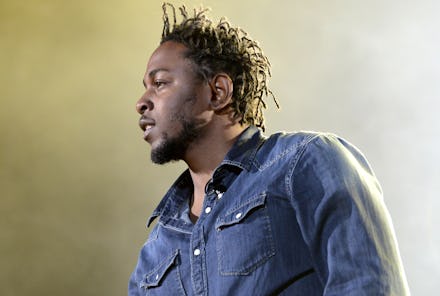The Story Behind How Kendrick Lamar Became the King of West Coast Rap

In November 1995, Dr. Dre and Tupac went to Compton, California, to shoot their "California Love" video. They stopped in the middle of the street by the Compton Swap Meet and got out to talk to the people. An 8-year-old Kendrick Lamar was there, sitting on his dad's shoulders, transfixed by the West Coast legends. "Subconsciously, it sparked something," Lamar told WGCI-FM's The Morning Riot. "I always kept thinking about that moment."
In the almost 20 years since then, Lamar has hustled his way into the company of those rappers he watched in 1995. He's now under the tutelage of Dre himself, and he spoke to Tupac posthumously on his fantastic new record, To Pimp a Butterfly. Some of the biggest West Coast rappers call Lamar the "king of West Coast rap" — an even more valuable credential than his two Grammy Awards, No. 1 record and a Generational Icon award from California's 35th Senate District.
None of that came easy. And the story behind how Lamar earned his crown only makes it shine brighter.
Young Duckworth: Before Lamar was leading West coast rap, he was Kendrick Lamar Duckworth, a young kid, growing as a part of a large extended family in Compton. His mother was one of 13 siblings, and each had six kids. Until Lamar was 13 years old, all of them lived in Compton.
"I'm 6 years old, seein' my uncles playing with shotguns, sellin' dope in front of the apartment," Lamar told LA Weekly. "My moms and pops never said nothing, 'cause they were young and living wild too."
K.Dot: Lamar first started writing his own raps at 13 — a few years after he saw Tupac. And when he first heard his voice play back on a recording at 16, he was locked in.
"Man, I wanted to keep hearing it," Lamar told The Morning Riot. "It was a high."
He released his first mixtape at 16 under the moniker K. Dot, entitled Hub City Threat: Minor of the Year. His flows, which are about as good as an average radio MC today, caught the ear of a local record producer Anthony "Top" Tiffith. He brought Lamar into the studio where, according to legend, Lamar freestyled for two hours until Tiffith gave him a deal.
His freestyling caught a lot of ears early on. One of his breakout moments came at a Charles Hamilton show, while he was still calling himself K.Dot. Hamilton "had this dope act as part of his show, where he'd jump into the crowd and rap against people that's in the crowd. I just happened to be in attendance," Lamar told the Well Versed, introducing some prized throwback footage, "and I did what I did and it almost turned into a lightweight battle."
Finding the message: As Lamar honed his craft and discipline, he lost many friends and family members. "I saw the same things over and over. A lot of my homeboys goin' to jail. Not, like, in and out. Sentences. And dyin' — it was a constant. It was a gift from God to be able to recognize that," he told Spin.
Lamar denies he ever participated on record, but stories of gang violence and drugs he saw growing up in Compton are the core of his discography. On "Average Joe," a song off Overly.Dedicated, the mixtape that pointed him toward his major label deal with Dre, he talks about being confronted and shot at by gang members just because he was from a rival neighborhood, though he wasn't gang affiliated himself.
"I got about 15 stories like 'Average Joe,'" Lamar told LA Weekly. But when Lamar tells them, they don't sound anything like what we've heard previously.
"We've been in Compton before," rapper Eminem, who's collaborated and toured with Lamar, told the New York Times. "But the way that Kendrick did it was so different. ... The album is crafted from front to back, the way each song ties into each other — to me that's genius."
Average joe with an old soul: The "Average Joe" story was one of the inspirations behind good kid m.A.A.d. city, Lamar's Grammy-nominated concept album. The record delves into the forces and stories that shape life in Compton.
"This project was in the works Kendrick's whole life. This is his life story," Punch, president of Lamar's label Top Dawg Entertainment, told Complex. "He had the concept before all of his mixtapes. This is the prequel to everything. He had the title for this album even before Kendrick Lamar EP had dropped. He was writing the concept the whole time."
That was the record that finally broke Lamar into the mainstream — and his star has only risen since. Lamar has since grown into a hip-hop leader, using his experiences to help others choose a path away from violence and self-destruction.
"My moms always told me, 'How long you gonna play the victim?'" Lamar recently told Rolling Stone. "I can say I'm mad and I hate everything, but nothing really changes until I change myself. So no matter how much bullshit we've been through as a community, I'm strong enough to say 'fuck that' and acknowledge myself and my own struggle."
His deeply autobiographical albums present his struggles battling depression and finding strength in defeat as a model to help spark that change.
"My new meaning for 'keepin' it gangsta' is totally different from the usual," Lamar recently told Mass Appeal. "It's really about takin' care of your family, handlin' your business and puttin' positive energy out there where everybody can benefit from it, not just yourself."
With his latest record-breaking album, Lamar has done more for that cause than nearly anyone else.